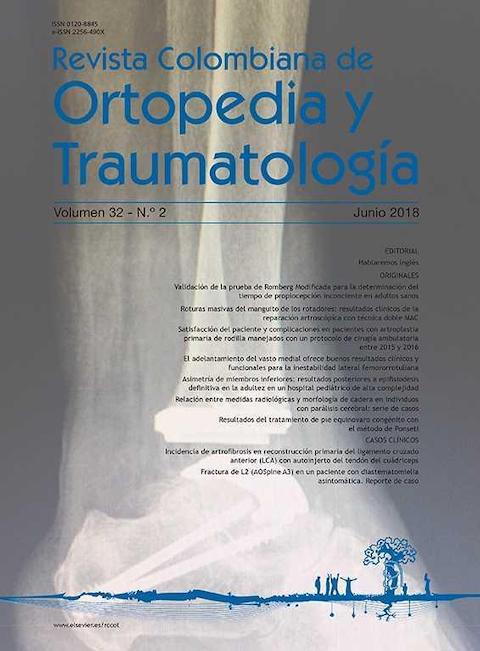Relationship between radiological measurements and hip morphology in subjects with cerebral palsy: case series
DOI:
https://doi.org/10.1016/j.rccot.2017.09.001Keywords:
cerebral palsy, hip, 3-D CT, musclesAbstract
Background: It is well known that the various minimally invasive approaches described improve outcomes for the surgical fixation of diaphyseal humerus fractures. However, there is a lack of information between the anatomical relationship of the radial nerve for the required incisions or for the position of the plate when a posterior approach is used. The objective of the study is to describe the anatomical relationship of the radial nerve with both incisions of the posterior minimally invasive approach, and with the distal tip of the osteosynthesis plate.
Materials and methods: A descriptive study was performed on cadavers without trauma of upper limbs, in prone with 45◦ of abduction of shoulder and 90◦ of elbow flexion. After sliding a plate of 2.7 mm, the distances of the radial nerve with respect to the reference points of the approach and distal tip of the plate were recorded in millimetres.
Results: A mean humeral length of 286.6 mm was found. The mean distance from the lateral epicondyle to the radial nerve was 155.1 mm. The mean distance from the tricipital aponeurosis to the radial nerve was 138.9 mm, and from the distal tip of the plate to the radial nerve was 155.6 mm.
Discussion: Plate fixation using minimal invasive technique using a posterior surgical approach may be safe for diaphyseal fractures of the humerus with respect to radial nerve injuries, as long as the plate screws are located outside the range of 128.5 mm to 169.5 mm measured from the tip of the plate. Clinical studies are required to demonstrate the safety of this approach.
Evidence level: IV.
Downloads
References
Dobson F, Boyd RN, Parrott J, Nattrass GR, Graham HK. Hip surveillance in children with cerebral palsy. Impact on the surgical management of spastic hip disease. J Bone Joint Surg Br. 2002;84:720-6. https://doi.org/10.1302/0301-620X.84B5.0840720
Boyd RN, Jordan R, Pareezer L, Moodie A, Finn C, Luther B, et al. Australian Cerebral Palsy Child Study: Protocol of a prospective population based study of motor and brain development of preschool aged children with cerebral palsy. BMC Neurol. 2013;13:57. https://doi.org/10.1186/1471-2377-13-57
Palisano R, Rosenbaum P, Walter S, Rusell D, Wood E, Galuppi B. Development and reliability of a system to classify gross motor function in children with cerebral palsy. Dev Med Child Neurol. 1997;39:214-23. https://doi.org/10.1111/j.1469-8749.1997.tb07414.x
Reimers J. The stability of the hip in children. A radiological study of the results of muscle surgery in cerebral palsy. Acta Orthop Scand Suppl. 1980;184:1-100. https://doi.org/10.3109/ort.1980.51.suppl-184.01
Hermanson M, Hägglund G, Riad J, Wagner P. Head-shaft angle is a risk factor for hip displacement in children with cerebral palsy. Acta Orthop. 2015;86:229-32. https://doi.org/10.3109/17453674.2014.991628
Chougule S, Dabis J, Petrie A, Daly K, Gelfer Y. Is head-shaft angle a valuable continuous risk factor for hip migration in cerebral palsy? J Child Orthop. 2016;10:651. https://doi.org/10.1007/s11832-016-0774-0
Kapandji AI. Cuadernos de fisiología articular II: Miembro inferior. 4.a edición Barcelona: Masson; 1990. p. 48-75.
Neumann DA. Kinesiology of the hip: a focus on muscular actions. J Orthop Sports Phys Ther. 2010;40:82-94. https://doi.org/10.2519/jospt.2010.3025
Has B, Nagy A, Has-Schön E, Pavi'c R, Kristek J, Splavski B. Influence of instability and muscular weakness in ethiopathogenesis of hip fractures. Coll Antropol. 2006;30:823-7.
Huiskes R. If bone is the answer, then what is the question? J Anat. 2000;197:145-56. https://doi.org/10.1046/j.1469-7580.2000.19720145.x
Magee DJ. Orthopedic physical assessment. Philadelphia: Saunders; 2002. p. 689-764.
Pope TL, Bloem HL, Beltran J, Morrison WB, Wilson DJ. Musculoskeletal imaging. 2 nd edition. Philadelphia: Elsevier; 2014. p. 284-306.
Doherty M, Courtney P, Doherty S, Jenkins W, Maciewicz RA, Muir K, et al. Non-spherical femoral head shape (pistol grip deformity), neck shaft angle, and risk of hip osteoarthritis: a case-control study. Arthritis Rheum. 2008;58:3172-82. https://doi.org/10.1002/art.23939
Alí-Morell OJ, Zurita-Ortega F, Martínez-Porcel R, GonzálezAstorga E, Cano-Mañas MJ. Registro de la actividad muscular en abductores y aductores en las alteraciones de cadera de los individuos con parálisis cerebral. Rehabilitación. 2013;47:35-43. https://doi.org/10.1016/j.rh.2013.01.001
Downloads
Published
How to Cite
Issue
Section
License
Copyright (c) 2024 Revista Colombiana de ortopedia y traumatología

This work is licensed under a Creative Commons Attribution 3.0 Unported License.




